Deck 25: In a Land of Plenty: Contentment and Discord, 1945-1960
Question
Question
Question
Question
Question
Question
Question
Question
Question
Question
Question
Question
Question
Question
Question
Question
Question
Question
Question
Question
Question
Question
Question
Question
Question
Question
Question
Question
Question
Question
Question
Question
Question
Question
Question
Question
Question
Question
Question
Question
Question
Question
Question
Question
Question
Question
Question
Question
Question
Question

Unlock Deck
Sign up to unlock the cards in this deck!
Unlock Deck
Unlock Deck
1/50
Play
Full screen (f)
Deck 25: In a Land of Plenty: Contentment and Discord, 1945-1960
1
How did journalist and social critic Vance Packard feel about American materialism in the postwar era as reflected by his commentary The Status Seekers?
A) He was critical of Americans who abandoned frugality in favor of conspicuous consumption.
B) He praised American workers who were able to climb the ladder of success to achieve an affluent lifestyle.
C) He feared that buying heavily on credit would mean that families could lose everything in a time of recession.
D) He was angry that manufacturers encouraged planned obsolescence of certain products after a few years so that consumers could buy more goods.
A) He was critical of Americans who abandoned frugality in favor of conspicuous consumption.
B) He praised American workers who were able to climb the ladder of success to achieve an affluent lifestyle.
C) He feared that buying heavily on credit would mean that families could lose everything in a time of recession.
D) He was angry that manufacturers encouraged planned obsolescence of certain products after a few years so that consumers could buy more goods.
He was critical of Americans who abandoned frugality in favor of conspicuous consumption.
2
What were Levittowns?
A) gated communities
B) planned suburban communities
C) public housing funded by the Fair Deal
D) segregated Southern communities
A) gated communities
B) planned suburban communities
C) public housing funded by the Fair Deal
D) segregated Southern communities
planned suburban communities
3
Southerners such as third-party presidential candidate Strom Thurmond left the Democratic Party in 1948 because of their `.
A) growing allegiance to the Republicans
B) contention that the party had abandoned organized labor
C) belief that the Soviet threat was not a serious concern
D) opposition to President Truman's civil rights reforms
A) growing allegiance to the Republicans
B) contention that the party had abandoned organized labor
C) belief that the Soviet threat was not a serious concern
D) opposition to President Truman's civil rights reforms
opposition to President Truman's civil rights reforms
4
What did President Truman threaten to do if railroad strikers did not get back to work?
A) use the army to run the railroads and draft the strikers into the military
B) jail the strikers as suspected members of the Communist Party
C) hire strikebreakers in their place to keep the railroads going
D) outlaw sympathy boycotts by other unions who wanted to support the strikers
A) use the army to run the railroads and draft the strikers into the military
B) jail the strikers as suspected members of the Communist Party
C) hire strikebreakers in their place to keep the railroads going
D) outlaw sympathy boycotts by other unions who wanted to support the strikers

Unlock Deck
Unlock for access to all 50 flashcards in this deck.
Unlock Deck
k this deck
5
What ushered in a more cautious era of labor organizing after 1955?
A) company owners being able to maintain control over management decisions after settlement of the 1946 strikes
B) the requirement of union officers to sign affidavits certifying they were not members of the Communist Party
C) the abolishment of the closed shop that required all workers to be in a union
D) the merger of the Congress of Industrial Organizations with the American Federation of Labor
A) company owners being able to maintain control over management decisions after settlement of the 1946 strikes
B) the requirement of union officers to sign affidavits certifying they were not members of the Communist Party
C) the abolishment of the closed shop that required all workers to be in a union
D) the merger of the Congress of Industrial Organizations with the American Federation of Labor

Unlock Deck
Unlock for access to all 50 flashcards in this deck.
Unlock Deck
k this deck
6
Civil rights reforms enacted by the Truman administration included .
A) the integration of all public facilities
B) requiring labor unions to admit African Americans
C) the desegregation of the armed forces
D) establishing the right to interracial marriages
A) the integration of all public facilities
B) requiring labor unions to admit African Americans
C) the desegregation of the armed forces
D) establishing the right to interracial marriages

Unlock Deck
Unlock for access to all 50 flashcards in this deck.
Unlock Deck
k this deck
7
How did American political and business leaders perceive material abundance in the postwar United States?
A) They feared that, if a recession hit, families risked losing everything.
B) They admired citizens' patriotism in purchasing American-made products.
C) They believed this demonstrated the superiority of capitalist societies over communist ones.
D) They were concerned that the public was becoming too dependent on credit.
A) They feared that, if a recession hit, families risked losing everything.
B) They admired citizens' patriotism in purchasing American-made products.
C) They believed this demonstrated the superiority of capitalist societies over communist ones.
D) They were concerned that the public was becoming too dependent on credit.

Unlock Deck
Unlock for access to all 50 flashcards in this deck.
Unlock Deck
k this deck
8
How does this photograph of black teenager Elizabeth Eckford trying to enter the all-white Central High School in 1957 most contradict the traditional image of the 1950s?
A) The photograph shows that racial integration was peaceful in a decade of turmoil.
B) The photograph demonstrates that teenagers were civically engaged in a time of complacency.
C) The photograph reveals that people in the 1950s took divergent political paths in a time of unanimity.
D) The photograph challenges the image of the 1950s as a tranquil period of ideological consensus.
A) The photograph shows that racial integration was peaceful in a decade of turmoil.
B) The photograph demonstrates that teenagers were civically engaged in a time of complacency.
C) The photograph reveals that people in the 1950s took divergent political paths in a time of unanimity.
D) The photograph challenges the image of the 1950s as a tranquil period of ideological consensus.

Unlock Deck
Unlock for access to all 50 flashcards in this deck.
Unlock Deck
k this deck
9
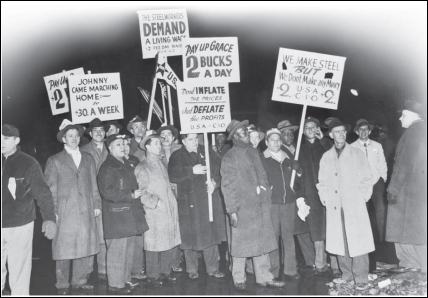
This 1946 photograph of striking steel workers demonstrates that the .
A) strikers were focused on shortening the work week
B) strikers did not support returning U.S. veterans
C) labor movement had become more integrated
D) labor movement had been infiltrated by communists

Unlock Deck
Unlock for access to all 50 flashcards in this deck.
Unlock Deck
k this deck
10
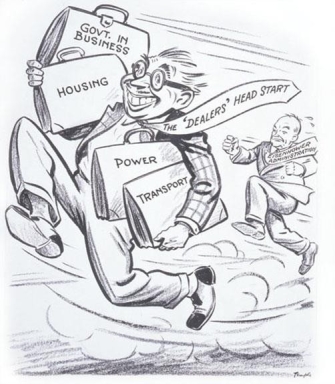
How does the 1953 editorial political cartoon Who Said 'Creeping Socialism' contradict what President Eisenhower had to say about domestic programs associated with the New and Fair Deals?
A) Eisenhower wanted to focus more on civil rights than other public programs.
B) Eisenhower announced that he had no intention of dismantling most of these programs.
C) Eisenhower wanted to dismantle these programs and desired more conservative ones in place.
D) Eisenhower believed that balancing the budget and limiting government spending was more important.

Unlock Deck
Unlock for access to all 50 flashcards in this deck.
Unlock Deck
k this deck
11
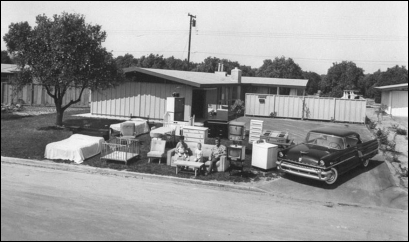
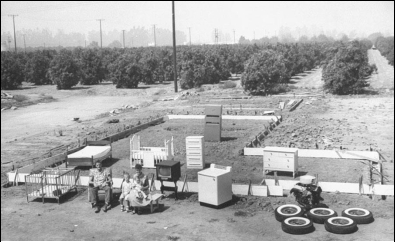
These two 1955 photographs of a suburban middle-class family called "What They Have" vs. "What They Own" featured in Life magazine demonstrate that American families .
A) moved to suburbs in great numbers
B) relied heavily on credit to maintain affluent lifestyles
C) were made up of a white-collar working father and a stay-at-home mother
D) benefitted greatly from New Deal and Fair Deal programs

Unlock Deck
Unlock for access to all 50 flashcards in this deck.
Unlock Deck
k this deck
12
How can the Taft-Hartley Act of 1947 best be described?
A) as a serious blow to the labor movement
B) as establishing such supports as the minimum wage
C) as an extension of Franklin Roosevelt's New Deal vision
D) as initiating an era of governmental regulation of business
A) as a serious blow to the labor movement
B) as establishing such supports as the minimum wage
C) as an extension of Franklin Roosevelt's New Deal vision
D) as initiating an era of governmental regulation of business

Unlock Deck
Unlock for access to all 50 flashcards in this deck.
Unlock Deck
k this deck
13
The 1944 GI Bill of Rights offered returning veterans .
A) low-interest home loans
B) significant tax breaks
C) white-collar employment
D) land grants
A) low-interest home loans
B) significant tax breaks
C) white-collar employment
D) land grants

Unlock Deck
Unlock for access to all 50 flashcards in this deck.
Unlock Deck
k this deck
14
Who was a business executive in the postwar era describing when he stated that these people's jobs were to "see that Americans are never satisfied"?
A) automobile manufacturers
B) advertisers
C) cigarette makers
D) credit card issuers
A) automobile manufacturers
B) advertisers
C) cigarette makers
D) credit card issuers

Unlock Deck
Unlock for access to all 50 flashcards in this deck.
Unlock Deck
k this deck
15
By 1960, what significant historic population threshold had the nation crossed?
A) There were more non-Christian rather than Christian members living in the United States.
B) There were more minorities than white Americans.
C) More Americans were living in urban areas rather than rural areas for the first time.
D) There were more middle class than working-class Americans.
A) There were more non-Christian rather than Christian members living in the United States.
B) There were more minorities than white Americans.
C) More Americans were living in urban areas rather than rural areas for the first time.
D) There were more middle class than working-class Americans.

Unlock Deck
Unlock for access to all 50 flashcards in this deck.
Unlock Deck
k this deck
16
What was the Fair Deal?
A) the term given to President Truman's stronger stand on civil rights
B) the Truman administration's attempt to dismantle the New Deal
C) a set of domestic reforms proposed by President Truman
D) the executive order that desegregated the armed forces
A) the term given to President Truman's stronger stand on civil rights
B) the Truman administration's attempt to dismantle the New Deal
C) a set of domestic reforms proposed by President Truman
D) the executive order that desegregated the armed forces

Unlock Deck
Unlock for access to all 50 flashcards in this deck.
Unlock Deck
k this deck
17
What term did Eisenhower use to describe the close ties between the defense industry and the Pentagon that might unduly influence government policy?
A) the "military-industrial complex"
B) the Fair Deal
C) "victory of the moderates"
D) "Creeping Socialism"
A) the "military-industrial complex"
B) the Fair Deal
C) "victory of the moderates"
D) "Creeping Socialism"

Unlock Deck
Unlock for access to all 50 flashcards in this deck.
Unlock Deck
k this deck
18
How did developer William Levitt borrow from Henry Ford's automobile industry when planning his communities?
A) Levitt paid his workers twice the average to ensure fast production.
B) Levitt hired armed guards to put down strikers and demonstrators.
C) Levitt used Ford's assembly line-style to develop standardized homes.
D) Levitt would not allow his construction workers to talk on the job.
A) Levitt paid his workers twice the average to ensure fast production.
B) Levitt hired armed guards to put down strikers and demonstrators.
C) Levitt used Ford's assembly line-style to develop standardized homes.
D) Levitt would not allow his construction workers to talk on the job.

Unlock Deck
Unlock for access to all 50 flashcards in this deck.
Unlock Deck
k this deck
19
Why did Republicans and conservative Southern Democrats try to undo the New Deal programs after the return of prosperity at the end of World War II?
A) These programs gave labor unions too much power and benefits.
B) These programs hampered the free market and deprived industrialists of the freedom to run their companies.
C) These politicians wanted to restrain the economic gains that African Americans made during the Great Depression.
D) These politicians feared that the New Deal had too many connections to socialism and communism.
A) These programs gave labor unions too much power and benefits.
B) These programs hampered the free market and deprived industrialists of the freedom to run their companies.
C) These politicians wanted to restrain the economic gains that African Americans made during the Great Depression.
D) These politicians feared that the New Deal had too many connections to socialism and communism.

Unlock Deck
Unlock for access to all 50 flashcards in this deck.
Unlock Deck
k this deck
20
How were the suburbs of the 1950s different from the earlier suburbs of the 1920s?
A) They consisted of homes that were frequently designed with unique features.
B) They were usually integrated between white and minority residents.
C) They were made up of larger homes than what could be found in the city.
D) They were farther away from city centers and depended on cars for transportation.
A) They consisted of homes that were frequently designed with unique features.
B) They were usually integrated between white and minority residents.
C) They were made up of larger homes than what could be found in the city.
D) They were farther away from city centers and depended on cars for transportation.

Unlock Deck
Unlock for access to all 50 flashcards in this deck.
Unlock Deck
k this deck
21
In the article "The Split-Level Trap," Good Housekeeping magazine stated that suburban children "have not been made to feel a sense of responsibility," thus arguing that suburban living
A) led to the decline of grades in school
B) spoiled children
C) encouraged children to volunteer in their communities
D) emphasized hard work, thrift, and patience in children
A) led to the decline of grades in school
B) spoiled children
C) encouraged children to volunteer in their communities
D) emphasized hard work, thrift, and patience in children

Unlock Deck
Unlock for access to all 50 flashcards in this deck.
Unlock Deck
k this deck
22
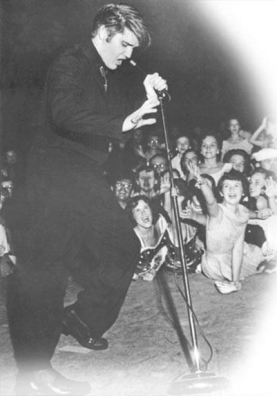
What was one major reason as shown in this photograph that rock-and-roll singer Elvis Presley contributed to the growing generation gap between parents and their teenaged children during the 1950s?
A) His "clean-cut" image was acceptable to parents but rejected by their adolescent children.
B) His suggestive moves enraged parents while gaining adoring teenaged fans.
C) Parents enjoyed his catchy lyrics and music while young people thought they sounded too "black."
D) Parents saw his success as a triumph for consumer tastes while their children saw it as the downfall of American civilization.

Unlock Deck
Unlock for access to all 50 flashcards in this deck.
Unlock Deck
k this deck
23
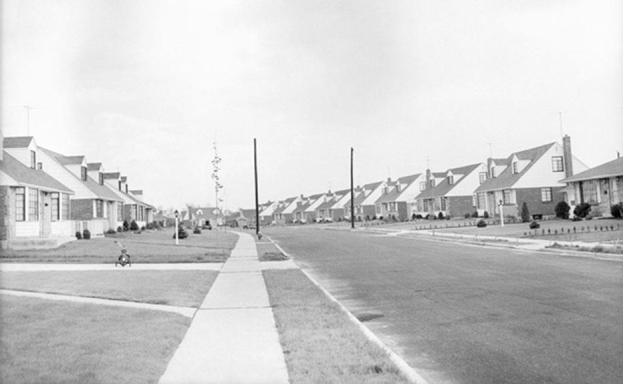
Based on this photograph of this street scene in Levittown, New York, what was one distinguishing feature of the postwar suburbs?
A) standardized homes lacking any distinguishing characteristics
B) narrow streets that made driving cars difficult
C) lack of yards for gardening or for children to play in
D) lack of safe paths for children to get to school or for walkers

Unlock Deck
Unlock for access to all 50 flashcards in this deck.
Unlock Deck
k this deck
24
How did Richard Nixon benefit from his televised 1952 "Checkers speech" after he was accused of having a secret fund financed by California businessmen?
A) He was elected governor of California.
B) He was able to save his place as the vice presidential candidate on the Republican ticket.
C) He became chairman of HUAC.
D) He was elected as president in the 1952 election.
A) He was elected governor of California.
B) He was able to save his place as the vice presidential candidate on the Republican ticket.
C) He became chairman of HUAC.
D) He was elected as president in the 1952 election.

Unlock Deck
Unlock for access to all 50 flashcards in this deck.
Unlock Deck
k this deck
25
Who was the first sitting president to appear on television?
A) Franklin D. Roosevelt
B) Harry Truman
C) Dwight Eisenhower
D) John F. Kennedy
A) Franklin D. Roosevelt
B) Harry Truman
C) Dwight Eisenhower
D) John F. Kennedy

Unlock Deck
Unlock for access to all 50 flashcards in this deck.
Unlock Deck
k this deck
26
Why did Americans who watched the televised 1960 presidential debate between Richard Nixon and John F. Kennedy believe Kennedy won while those who listened to it on radio felt that Nixon had won?
A) Kennedy appeared more comfortable and attractive on television.
B) Kennedy spoke more eloquently than Nixon.
C) Kennedy had a large fan base in the television audience.
D) Kennedy appeared sickly and gained the audience's sympathy.
A) Kennedy appeared more comfortable and attractive on television.
B) Kennedy spoke more eloquently than Nixon.
C) Kennedy had a large fan base in the television audience.
D) Kennedy appeared sickly and gained the audience's sympathy.

Unlock Deck
Unlock for access to all 50 flashcards in this deck.
Unlock Deck
k this deck
27
The writings of Beat author Jack Kerouac .
A) were condemned as communist during the McCarthy hearings
B) supported the passage of additional social reform programs
C) advocated against conformity and consumerism
D) combined psychology and religion to promote positive thinking
A) were condemned as communist during the McCarthy hearings
B) supported the passage of additional social reform programs
C) advocated against conformity and consumerism
D) combined psychology and religion to promote positive thinking

Unlock Deck
Unlock for access to all 50 flashcards in this deck.
Unlock Deck
k this deck
28
One significant trend of the years 1946-1964 was .
A) the expansion of the working class
B) ongoing growth in the power of organized labor
C) easing fears regarding the threat of communism
D) a dramatic increase in the birth rate
A) the expansion of the working class
B) ongoing growth in the power of organized labor
C) easing fears regarding the threat of communism
D) a dramatic increase in the birth rate

Unlock Deck
Unlock for access to all 50 flashcards in this deck.
Unlock Deck
k this deck
29
Although the first commercial television transmission occurred in 1939, why was it not until the early 1950s that television really took off with the American public?
A) American entrepreneurs were more concerned with containing communism.
B) The high rise in prices after World War II made it too expensive to afford televisions.
C) World War II slowed down the production of televisions.
D) The railroad strikes of the late 1940s hampered the growth of television production.
A) American entrepreneurs were more concerned with containing communism.
B) The high rise in prices after World War II made it too expensive to afford televisions.
C) World War II slowed down the production of televisions.
D) The railroad strikes of the late 1940s hampered the growth of television production.

Unlock Deck
Unlock for access to all 50 flashcards in this deck.
Unlock Deck
k this deck
30
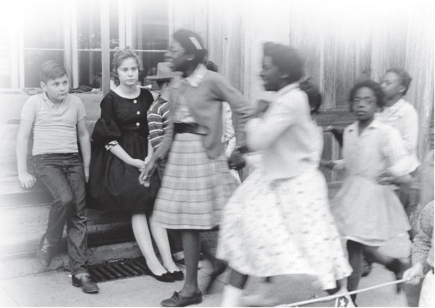
What does this photograph of children visiting town demonstrate about racial customs in the South?
A) Black children enjoyed town, but white children did not.
B) White children were taught to be unsmiling and quiet.
C) White children generally preferred to be at home.
D) Whites and blacks kept apart even from a young age.

Unlock Deck
Unlock for access to all 50 flashcards in this deck.
Unlock Deck
k this deck
31
Allan Ginsberg's controversial 1955 poem Howl portrayed _.
A) protests against the Cold War and communism
B) the problems related to affluence and conspicuous consumption by the middle class
C) rebellion by middle-class suburban teenagers against their parents
D) the lives of those who lived beyond the mainstream of American life
A) protests against the Cold War and communism
B) the problems related to affluence and conspicuous consumption by the middle class
C) rebellion by middle-class suburban teenagers against their parents
D) the lives of those who lived beyond the mainstream of American life

Unlock Deck
Unlock for access to all 50 flashcards in this deck.
Unlock Deck
k this deck
32
What earlier ruling was overturned by Brown v. Board of Education?
A) Marbury v. Madison
B) McCulloch v. Maryland
C) Santa Clara County v. Southern Pacific Railroad
D) Plessy v. Ferguson
A) Marbury v. Madison
B) McCulloch v. Maryland
C) Santa Clara County v. Southern Pacific Railroad
D) Plessy v. Ferguson

Unlock Deck
Unlock for access to all 50 flashcards in this deck.
Unlock Deck
k this deck
33
What did American writer John Keats mean when he wrote in The Crack in the Picture Window that Americans could purchase a "box" in a suburban development "inhabited by people whose age, income, number of children, problems, habits, conversation, dress, possessions, and perhaps even blood type are also precisely like [theirs]"?
A) Suburban homes were made affordable because of standardized construction.
B) Suburban living encouraged mindless conformity and a lack of diversity.
C) Suburbanites usually lived in isolation from each other.
D) Suburban living was limited to the upper class.
A) Suburban homes were made affordable because of standardized construction.
B) Suburban living encouraged mindless conformity and a lack of diversity.
C) Suburbanites usually lived in isolation from each other.
D) Suburban living was limited to the upper class.

Unlock Deck
Unlock for access to all 50 flashcards in this deck.
Unlock Deck
k this deck
34
Many social critics like C. Wright Mills believed that, like the suburbs, white-collar jobs
A) would likely fade in importance
B) were harmful to the environment
C) stifled individuality
D) were a drain on the economy
A) would likely fade in importance
B) were harmful to the environment
C) stifled individuality
D) were a drain on the economy

Unlock Deck
Unlock for access to all 50 flashcards in this deck.
Unlock Deck
k this deck
35
How were middle-class American women portrayed in most popular televised comedy sitcoms, such as I Love Lucy, Father Knows Best, and Leave It to Beaver, during the 1950s?
A) as independent working women in white-collar jobs
B) as defiant housewives who stood up to domineering husbands
C) as spouses who were satisfied with their roles as caring mothers and devoted wives
D) as single mothers struggling to raise their children
A) as independent working women in white-collar jobs
B) as defiant housewives who stood up to domineering husbands
C) as spouses who were satisfied with their roles as caring mothers and devoted wives
D) as single mothers struggling to raise their children

Unlock Deck
Unlock for access to all 50 flashcards in this deck.
Unlock Deck
k this deck
36
What was one common feature of a postwar suburban home?
A) a lack of a garage for the family car
B) a separate kitchen and dining room
C) a second story to add more bedrooms as the child population grew
D) a large living room picture window that made the house appear more spacious
A) a lack of a garage for the family car
B) a separate kitchen and dining room
C) a second story to add more bedrooms as the child population grew
D) a large living room picture window that made the house appear more spacious

Unlock Deck
Unlock for access to all 50 flashcards in this deck.
Unlock Deck
k this deck
37
What effect did President Eisenhower's statement "If a citizen has to be bored to death it is cheaper and more comfortable to sit at home and look at television than it is to go outside and pay a dollar for a ticket" have on American popular culture in the 1950s?
A) The film industry remained more productive than the television industry.
B) The number of televisions in American households declined.
C) Drive-in movie theaters grew in number and popularity.
D) Many movie theaters closed and studios made fewer films.
A) The film industry remained more productive than the television industry.
B) The number of televisions in American households declined.
C) Drive-in movie theaters grew in number and popularity.
D) Many movie theaters closed and studios made fewer films.

Unlock Deck
Unlock for access to all 50 flashcards in this deck.
Unlock Deck
k this deck
38
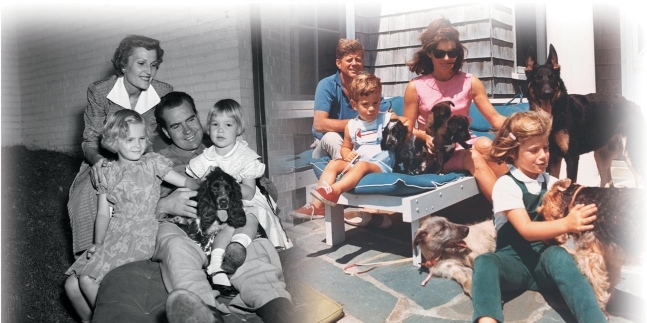
What do these photographs of the 1960 presidential candidates Richard Nixon and John F. Kennedy pictured with their families reveal about the American public in the postwar era?
A) its tendency to pry into the lives of others
B) its distrust of politicians
C) its emphasis on idealized family life
D) its obsession with celebrity life

Unlock Deck
Unlock for access to all 50 flashcards in this deck.
Unlock Deck
k this deck
39
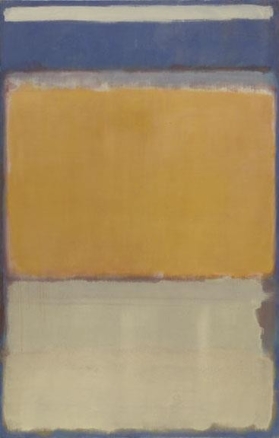
In what way does artist Mark Rothko's painting No. 10 represent the break that Abstract Expressionism made from the art that prevailed between the 1930s and 1950s?
A) It was clearly made by an artist with no training.
B) It deliberately conveyed no specific message.
C) It portrayed the world realistically.
D) It was largely closed to interpretation by viewers.

Unlock Deck
Unlock for access to all 50 flashcards in this deck.
Unlock Deck
k this deck
40
The success of 1950s films such as The Wild One and Rebel Without a Cause .
A) illustrated a growing angst among America's youth
B) showed that moviegoers preferred comedies with light themes
C) renewed interest in the movie industry while television sales declined
D) reaffirmed the complacency associated with this decade
A) illustrated a growing angst among America's youth
B) showed that moviegoers preferred comedies with light themes
C) renewed interest in the movie industry while television sales declined
D) reaffirmed the complacency associated with this decade

Unlock Deck
Unlock for access to all 50 flashcards in this deck.
Unlock Deck
k this deck
41
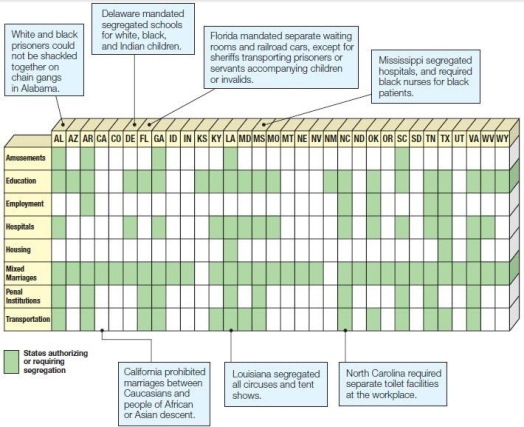
What do these statutes suggest about daily life for African Americans in the United States?
A) Restrictions on African American daily life were limited to Southern states.
B) The races had many opportunities for mixing in their daily lives.
C) Civil rights was more of a regional rather than a national problem.
D) Daily life was filled with reminders of oppression and discrimination.

Unlock Deck
Unlock for access to all 50 flashcards in this deck.
Unlock Deck
k this deck
42
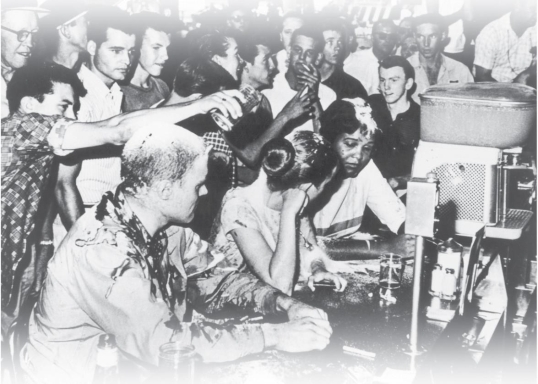
What does this photograph of a sit-in at a Woolworth's lunch counter in Mississippi demonstrate about the power of nonviolent protest?
A) It encouraged outsiders to sit down and join in the protest.
B) It inspired the protesters' opponents to turn away from violence.
C) It protected the protesters from assailants.
D) It made the protesters' antagonists look unsympathetic to outsiders.

Unlock Deck
Unlock for access to all 50 flashcards in this deck.
Unlock Deck
k this deck
43
What was the major social reason why the Supreme Court ruled that segregated schools were unconstitutional in the case of Brown v. Board of Education?
A) Research showed that segregation taught African American children to accept their inferiority to whites.
B) African American students were taught by unqualified black teachers.
C) Segregated schools violated the equal protection clause of the Fourteenth Amendment.
D) Black children had been kept apart from white children from a young age.
A) Research showed that segregation taught African American children to accept their inferiority to whites.
B) African American students were taught by unqualified black teachers.
C) Segregated schools violated the equal protection clause of the Fourteenth Amendment.
D) Black children had been kept apart from white children from a young age.

Unlock Deck
Unlock for access to all 50 flashcards in this deck.
Unlock Deck
k this deck
44
When Arkansas governor Orval Faubus resisted the Supreme Court-mandated integration of public schools in Little Rock, President Eisenhower .
A) quietly supported the actions of the governor
B) urged Congress to pass civil rights legislation
C) sent federal troops to Little Rock to protect the Little Rock Nine
D) required that state troops be used to protect the Little Rock Nine
A) quietly supported the actions of the governor
B) urged Congress to pass civil rights legislation
C) sent federal troops to Little Rock to protect the Little Rock Nine
D) required that state troops be used to protect the Little Rock Nine

Unlock Deck
Unlock for access to all 50 flashcards in this deck.
Unlock Deck
k this deck
45
Martin Luther King Jr. was a co-founder of the .
A) Congress of Racial Equality
B) National Association for the Advancement of Colored People
C) Student Nonviolent Coordinating Committee
D) Southern Christian Leadership Conference
A) Congress of Racial Equality
B) National Association for the Advancement of Colored People
C) Student Nonviolent Coordinating Committee
D) Southern Christian Leadership Conference

Unlock Deck
Unlock for access to all 50 flashcards in this deck.
Unlock Deck
k this deck
46
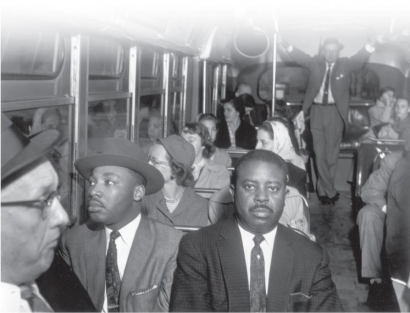
How did the experience of many black riders on Montgomery city buses after integration contrast with the ride taken by Martin Luther King, Jr. and Ralph Abernathy immediately after the boycott was lifted?
A) Many black riders decided to continue the boycott.
B) Many black riders encountered violence.
C) Black riders typically rode on more crowded buses.
D) Black riders typically rode without a companion.

Unlock Deck
Unlock for access to all 50 flashcards in this deck.
Unlock Deck
k this deck
47
What made Emmett Till's 1955 murder in Mississippi different from previous racist killings of African Americans in the South?
A) This was the first time that a black teenager tried to advance the Civil Rights Movement.
B) Emmet Till was the youngest African American victim of racist violence in the United States.
C) Till's family decided to fight back by publicizing his battered body and speaking in court.
D) The jury failed to convict the accused murderers.
A) This was the first time that a black teenager tried to advance the Civil Rights Movement.
B) Emmet Till was the youngest African American victim of racist violence in the United States.
C) Till's family decided to fight back by publicizing his battered body and speaking in court.
D) The jury failed to convict the accused murderers.

Unlock Deck
Unlock for access to all 50 flashcards in this deck.
Unlock Deck
k this deck
48
When ordered to give her seat to a white passenger on a Montgomery, Alabama, city bus, Rose Parks chose to .
A) appeal to the local courts
B) obey the order, which was consistent with a local ordinance
C) vacate her seat but protest by joining a bus boycott
D) remain seated and risk arrest
A) appeal to the local courts
B) obey the order, which was consistent with a local ordinance
C) vacate her seat but protest by joining a bus boycott
D) remain seated and risk arrest

Unlock Deck
Unlock for access to all 50 flashcards in this deck.
Unlock Deck
k this deck
49
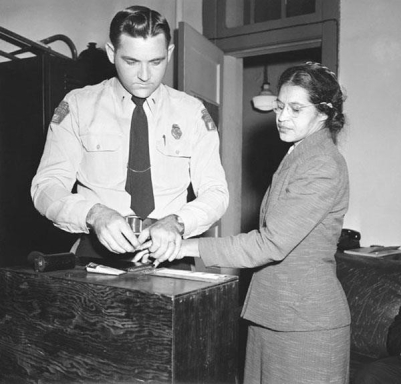
What does this photograph of Rosa Park's 1955 arrest most accurately reveal about her role in instigating the Montgomery Bus Boycott?
A) She was part of a well-organized movement that the NAACP led to test the bus segregation law.
B) She was simply a tired seamstress who impulsively decided to stay seated when asked to move.
C) She decided to participate in a planned one-day bus boycott to avoid potential violence.
D) She was violently beaten in jail after her arrest.

Unlock Deck
Unlock for access to all 50 flashcards in this deck.
Unlock Deck
k this deck
50
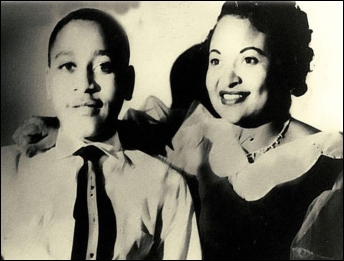
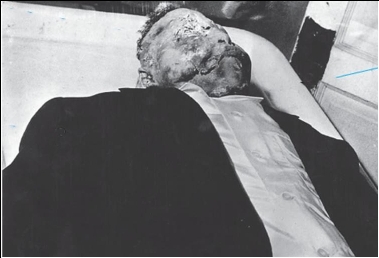
Why did the black Northern press choose to pair the image of Emmett Till's battered corpse with that of a smiling image of him with his mother Mamie Till-Bradley?
A) They wanted to convince the Mississippi jury to convict Till's murderers.
B) They wanted to outrage their audience by showing how an innocent young boy was savagely beaten to death by racists.
C) They wanted to caution their audience of what could happen to African Americans in the South if they were too forward with white people.
D) They wanted to warn their audience of what could happen to anyone who played an active role in the Civil Rights Movement in the South.

Unlock Deck
Unlock for access to all 50 flashcards in this deck.
Unlock Deck
k this deck



